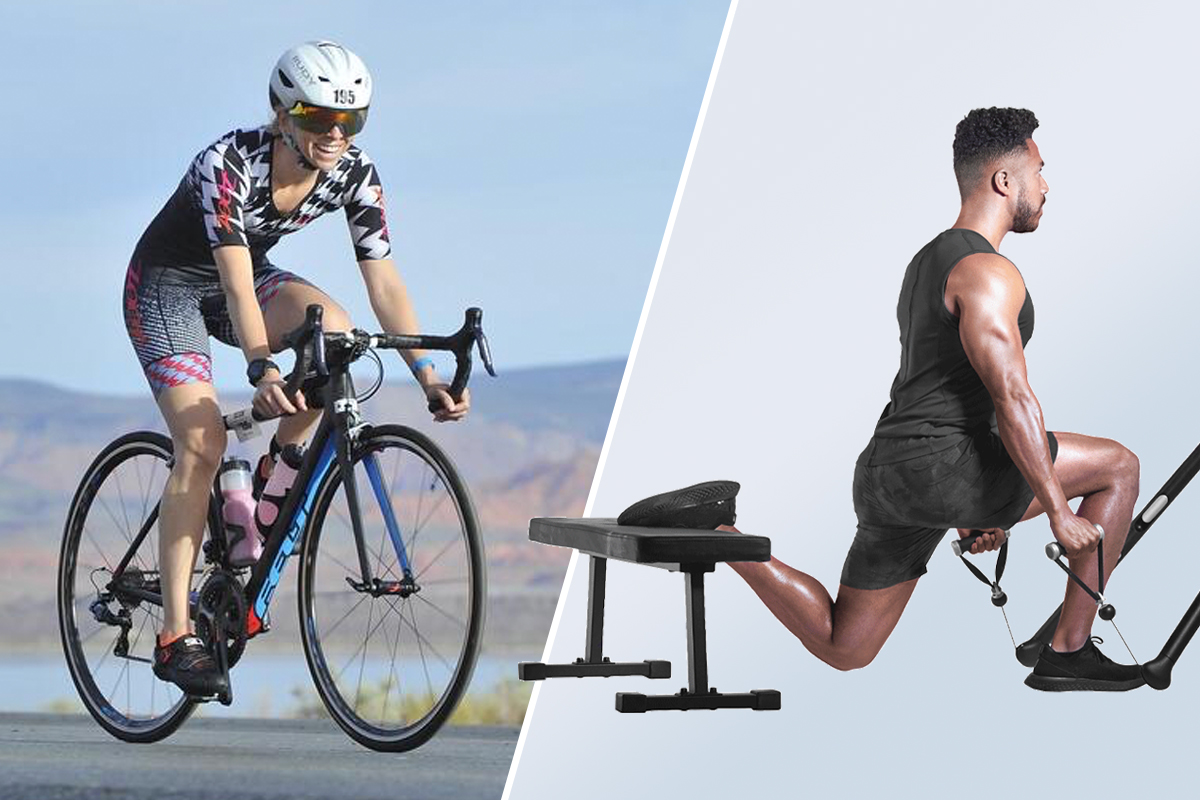Contents
I. Introduction to Cycling Workouts

Cycling workouts are a fantastic way to improve your fitness and overall health. Whether you’re a professional cyclist or just starting out, incorporating cycling into your exercise routine can bring numerous benefits. Not only does it provide an effective cardiovascular workout, but it also helps build strength, endurance, and agility.
1. Benefits of Cycling Workouts
Cycling workouts offer a wide range of benefits for both the body and mind. Firstly, they are low impact exercises that put less stress on your joints compared to activities such as running or high-impact aerobics. This makes it an ideal option for individuals with joint pain or injuries.
Additionally, cycling engages multiple muscle groups including the quadriceps, hamstrings, calves, glutes, and core muscles. Regular cycling workouts help tone these muscles while also improving their strength and flexibility.
Another advantage of cycling is its ability to enhance cardiovascular fitness by increasing heart rate and lung capacity. This leads to improved blood circulation throughout the body and better oxygen delivery to the muscles.
Mentally, cycling can be a great stress-reliever as it allows you to enjoy nature while getting some exercise. It boosts mood by releasing endorphins in the brain which promote feelings of happiness and well-being.
2. Types of Cycling Workouts
There are various types of cycling workouts that cater to different goals and fitness levels:
- Aerobic Endurance Rides: These longer rides at a moderate pace focus on building stamina and improving cardiovascular fitness.
- Sprint Intervals: Short bursts of intense effort followed by recovery periods help increase speed and power output.
- Hill Climbs: Riding uphill challenges your muscles and builds strength, particularly in the legs.
- Interval Training: Alternating between high-intensity efforts and recovery periods improves both aerobic and anaerobic fitness.
- Cross-Training Rides: Incorporating other exercises like strength training or yoga during your cycling sessions provides a well-rounded workout.
The type of workout you choose depends on your personal goals, fitness level, and available time. It’s important to start gradually and listen to your body to avoid overexertion or injury. Consulting with a professional trainer can help you create a tailored cycling workout plan that suits your individual needs.
3. Safety Precautions
Prioritizing safety is crucial when engaging in cycling workouts. Here are some key precautions to keep in mind:
- Wear Protective Gear: Always wear a helmet that fits properly and consider additional protective gear such as knee pads or elbow guards if needed.
- Maintain Your Bike: Regularly check the brakes, tires, gears, and chain for any signs of damage or wear. Keep your bike clean and lubricated for optimal performance.
- Familiarize Yourself with Traffic Rules: Obey traffic laws, use hand signals when turning or stopping, be aware of your surroundings, and ride defensively at all times.
- Avoid Distractions: Refrain from using electronic devices while riding as it can distract you from the road ahead. Stay focused on the path ahead to prevent accidents.
II. Benefits of Cycling Workouts

Cycling workouts offer numerous benefits for both physical and mental well-being. Incorporating cycling into your fitness routine can help you achieve your goals while enjoying the great outdoors or the comfort of an indoor stationary bike. Here are some of the key advantages that cycling workouts bring:
1. Cardiovascular Health Improvement
Cycling is a fantastic way to boost cardiovascular health, as it gets your heart pumping and increases blood circulation throughout your body. Regular cycling workouts can strengthen your heart muscles, lower blood pressure, and reduce the risk of heart diseases.
2. Weight Loss and Management
If weight loss is one of your goals, cycling workouts can be highly effective in shedding those extra pounds. Engaging in regular cycling sessions helps burn calories, build muscle mass, increase metabolism, and improve overall body composition.
3. Joint-Friendly Exercise
Cycling is a low-impact exercise that puts minimal stress on joints compared to activities like running or high-intensity interval training (HIIT). It allows individuals with joint issues or injuries to engage in a full-body workout without exacerbating pain or discomfort.
4. Muscle Strengthening
Pedaling engages various muscle groups simultaneously – including quadriceps, hamstrings, calves, glutes, and core muscles – making it an excellent way to tone and strengthen these areas over time.
5. Reduced Stress Levels
Riding a bike outdoors not only provides fresh air but also allows you to immerse yourself in nature’s beauty while engaging in physical activity. This combination has been proven to reduce stress levels significantly by releasing endorphins (feel-good hormones) that enhance mood and relieve anxiety.
6. Increased Mental Clarity and Focus
Cycling workouts can help improve cognitive function by increasing blood flow to the brain. Regular exercise has been associated with better memory, enhanced creativity, heightened concentration, and improved overall mental clarity.
7. Improved Sleep Quality
Engaging in physical activity such as cycling can positively impact your sleep patterns and quality of rest. Regular workouts help regulate your body’s internal clock, promoting deeper and more restful sleep.
8. Social Engagement
Cycling can be a social activity that allows you to connect with like-minded individuals through group rides or cycling clubs. This social aspect not only provides motivation but also enhances your support system while enjoying the benefits of outdoor activities together.
Incorporating cycling workouts into your fitness routine can bring about these significant benefits for your physical health, mental well-being, and overall quality of life.
III. Types of Cycling Workouts

When it comes to cycling workouts, there are various types that cater to different fitness goals and preferences. Whether you’re a beginner or an experienced cyclist, incorporating a variety of workouts into your routine can help you stay motivated and continuously challenge yourself. Here are some popular types of cycling workouts:
Sprint Intervals
Sprint intervals involve short bursts of high-intensity efforts followed by periods of active recovery. These workouts are great for improving speed and power. To perform sprint intervals, find a flat stretch of road or use stationary bikes with adjustable resistance.
Hill Climbing
Hill climbing is an excellent workout for building strength and endurance. Find hilly routes in your area or adjust the resistance on your indoor bike to simulate uphill climbs. Focus on maintaining a steady pace while pedaling uphill, and use proper technique to engage your leg muscles effectively.
Endurance Rides
If you’re looking to build stamina and increase your overall cycling distance, endurance rides are ideal. These longer rides at a moderate intensity help improve cardiovascular fitness while challenging mental resilience. Gradually increase the duration and distance of your rides over time.
Interval Training
Interval training involves alternating between periods of high-intensity efforts and active recovery phases. This type of workout is effective for boosting both aerobic capacity and fat burning. You can vary the duration and intensity of each interval based on your fitness level.
Cross-Training Workouts
Incorporating cross-training exercises into your routine can provide additional benefits for cyclists by targeting different muscle groups while improving overall strength, flexibility, and balance. Activities like yoga, swimming, or weightlifting can complement your cycling performance.
Remember to warm up before every workout and cool down afterward to prevent injuries. Additionally, listen to your body and adjust the intensity or duration of your workouts as needed. Consulting with a professional cycling coach can also help you develop a personalized training plan that aligns with your specific goals.
IV. Setting Up Your Cycling Workouts

When it comes to setting up your cycling workouts, there are a few key factors to consider in order to maximize your training and achieve optimal results. Here are some important aspects to keep in mind:
Determine Your Goals
The first step in setting up your cycling workouts is determining your goals. Are you looking to improve endurance, increase speed, or train for a specific event? Knowing what you want to achieve will help guide the structure and intensity of your workouts.
Create a Training Plan
Once you have established your goals, it’s time to create a training plan that aligns with them. This involves mapping out the frequency, duration, and intensity of your rides. Consider incorporating different types of workouts such as interval training, hill repeats, or long endurance rides.
Vary Your Workouts
To prevent boredom and keep challenging yourself, it’s essential to vary your workouts. Mix up the terrain by including both hilly routes and flat roads in your training plan. Additionally, incorporate different intensities by alternating between high-intensity intervals and recovery periods.
Track Your Progress
In order to gauge the effectiveness of your cycling workouts, tracking your progress is crucial. Use technology such as GPS devices or smartphone apps that can record data like distance covered, average speed, and heart rate during each ride. This information will help you analyze improvements over time.
Listen To Your Body
Your body knows best when it comes to its limits and recovery needs. It’s important not to push yourself too hard without giving enough time for rest and recovery between sessions. Pay attention to any signs of fatigue or injury; if necessary, adjust the intensity or take a day off to allow your body to recuperate.
Stay Consistent
Consistency is key in achieving long-term progress. Make sure to stick to your training plan and try not to skip workouts unless absolutely necessary. Consistent training will help build endurance, improve performance, and make you a stronger cyclist overall.
By following these guidelines for setting up your cycling workouts, you’ll be on your way to reaching new levels of fitness and enjoying the many benefits that cycling has to offer.
V. Essential Equipment for Cycling Workouts
When it comes to cycling workouts, having the right equipment is essential to ensure a safe and effective experience. Whether you are a beginner or an experienced cyclist, investing in the following equipment will greatly enhance your cycling sessions:
1. Bike
A high-quality bike is the foundation of any cycling workout routine. There are various types of bikes available, such as road bikes, mountain bikes, and hybrid bikes. Choose one that suits your specific needs and preferences.
2. Helmet
Your safety should be a top priority during cycling workouts, which is why wearing a helmet is crucial. Look for helmets that provide adequate protection and ensure proper fit to minimize the risk of head injuries.
3. Cycling Shoes
Cycling shoes are designed with stiff soles that efficiently transfer power from your legs to the pedals, improving pedaling efficiency and reducing fatigue. They also offer better grip on the pedals and prevent foot slippage.
4. Appropriate Clothing
Dress comfortably in moisture-wicking clothing suitable for cycling workouts. Opt for padded shorts to reduce friction and chafing during long rides.
5. Water Bottle Cage
To stay hydrated throughout your workout, attach a water bottle cage onto your bike frame or handlebars. This allows easy access to water whenever you need it without interrupting your ride.
6. Bike Lights
If you plan on cycling early in the morning or late at night when visibility may be reduced, invest in front and rear bike lights for added safety on the road.
Remember:
– Use H2 tag to wrap section title.
– Use H3 tags for subheadings.
– Use p tag to write content.
VI. Safety Tips for Cycling Workouts

Shelby Cortez is a dynamic and passionate individual with a strong background in the fitness industry. With a Bachelor’s degree in Exercise Science from the prestigious University of California, she has gained extensive knowledge about the human body and its mechanics. Shelby’s dedication to fitness goes beyond her education, as she has spent years honing her skills as a personal trainer and group fitness instructor. Her expertise in workout routines and nutrition has helped countless individuals achieve their fitness goals. Shelby’s commitment to health and wellness is evident in her own lifestyle, as she consistently pushes herself to new limits in the gym. Whether it’s weightlifting, yoga, or HIIT workouts, Shelby Cortez is the go-to expert for all things fitness-related.
